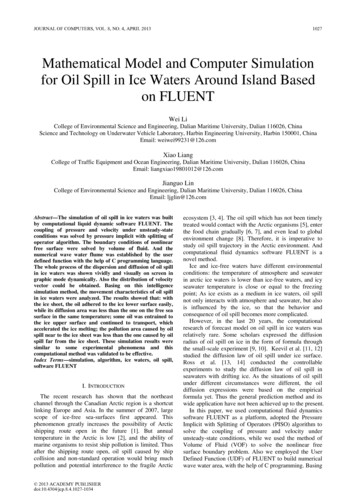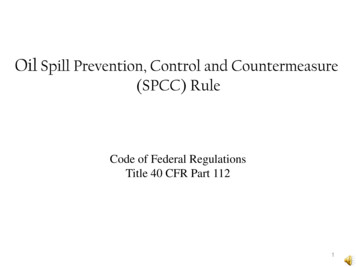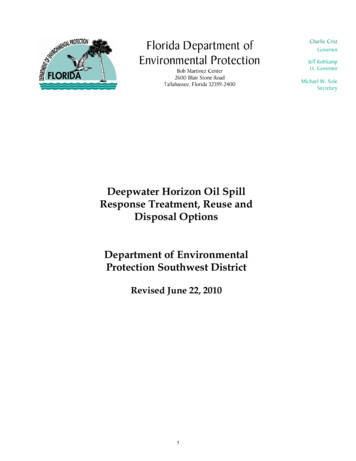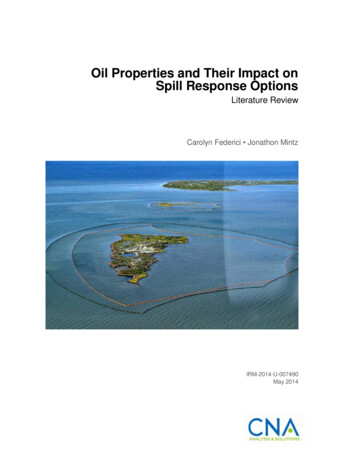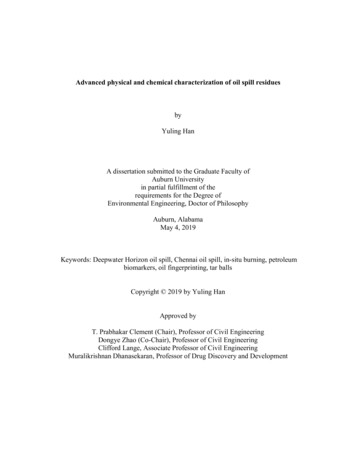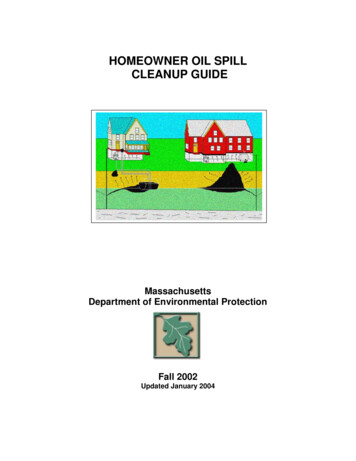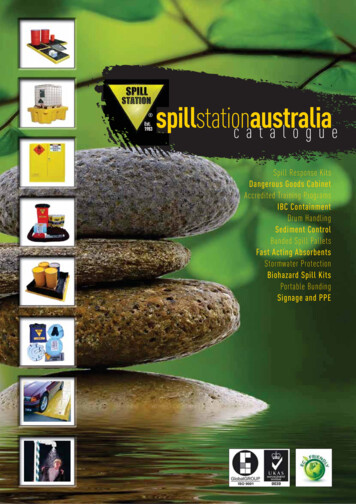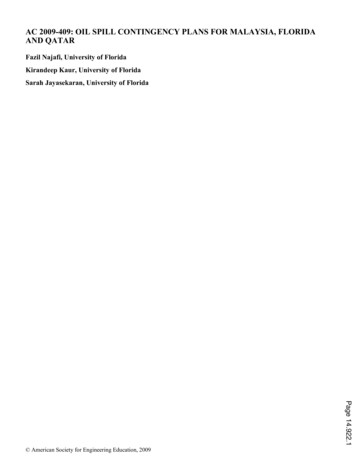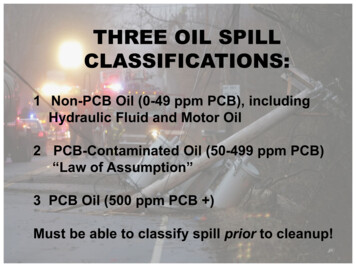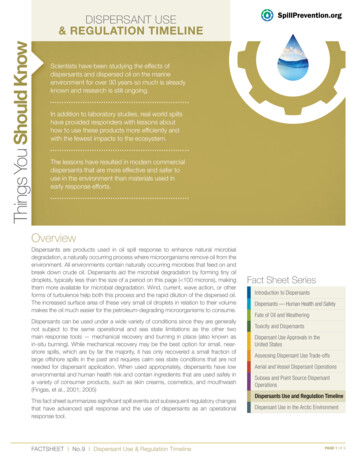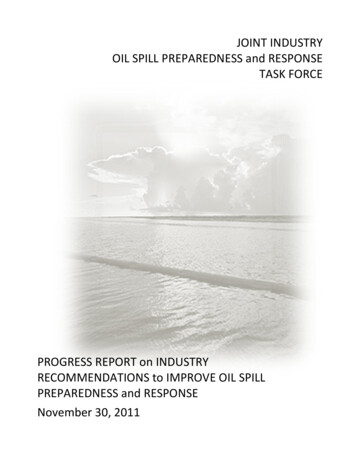
Transcription
JOINT INDUSTRYOIL SPILL PREPAREDNESS and RESPONSETASK FORCEPROGRESS REPORT on INDUSTRYRECOMMENDATIONS to IMPROVE OIL SPILLPREPAREDNESS and RESPONSENovember 30, 2011
JITF Progress Report November 2011This page intentionally left blank.
JITF Progress Report November 2011Table of Contents1. Introduction . 12. Oil Spill Preparedness and Response Joint Industry Task Force Organization . 13. Oil Spill Preparedness and Response Joint Industry Task Force Recommendations . 43.1 Planning. 113.1.1 Planning Guidelines for Oil Spill Response Plans . 113.1.2 Sharing of Company Personnel . 113.1.3 Sharing of Oil Spill Removal Organizations’ Resources. 123.1.4 Recommended Practice for Worst Case Discharge . 123.1.5 Memorandum of Understanding for Cascading Equipment. 133.1.6 Deepwater Horizon Technology Evaluation . 133.1.7 Lessons Learned Sharing . 143.1.8 Volunteer Guidelines . 143.1.9 Improvements to Training and Exercises . 143.1.10 Area Contingency Plan Enhancements . 143.2 Dispersants. 153.2.1 Develop Improved Communication Tools . 153.2.2 Panel to Evaluate/Recommend Studies . 163.2.3 Subsea Injection . 173.2.4 Review Surface Application Techniques . 193.2.5 Improvements to Decision-Making and Use. 193.3 Shoreline Protection and Cleanup . 213.3.1 Recommended Practice for Personal Protective Equipment . 213.3.2 Assess Shoreline Protection Technologies . 213.3.3 Environmental Sensitivity Index Mapping . 223.4 Oil Sensing and Tracking . 223.4.1 Assess Remote Sensing Technologies . 223.5 In-Situ Burning . 233.5.1 In-Situ Burn Program. 233.6 Mechanical Recovery . 243.6.1 Research & Development and Technology Tracking Program . 24i
JITF Progress Report November 20113.6.2 Vessels of Opportunity Program . 253.6.3 Effective Daily Recovery Capacity Assessment . 253.7 Alternative Technologies . 263.7.1 Concurrent Incident Evaluation . 263.7.2 Non-Incident Evaluation . 264. Conclusion . 26Figures and TablesFigure 1: OSPR Project Organization . 3Table 1: API OSPR Projects as Related to Original Recommendations . 5ii
JITF Progress Report November 2011LIST OF SRPPHMSAPPER&DRRTSEMSSMARTArea CommitteeArea Contingency PlanAdvanced Notice of Proposed RulemakingApplication for a Permit to DrillAmerican Petroleum InstituteBureau of Ocean Energy ManagementBureau of Safety and Environmental EnforcementCoastal Response Research CenterDepartment of TransportationDeepwater HorizonEffective Daily Recovery CapacityEnvironmental Protection AgencyEnvironmental Sensitivity IndexFood and Drug AdministrationFederal On-Scene CoordinatorGlobal Industry Response GroupGulf of MexicoGulf of Mexico Research InitiativeIncident Command StructureIn-Situ BurningInternational Petroleum Industry Environmental Conservation AssociationJoint Industry Task ForceJoint Industry ProjectLessons Learned Information SharingMemorandum of UnderstandingNet Environmental Benefit AnalysisNon-Government OrganizationNational Institute for Occupational Safety and HealthNational Oceanographic and Atmospheric AdministrationNational Response GroupNational Schedule Coordinating CommitteeNotice to LesseesInternational Association of Oil & Gas ProducersOffshore Operators CommitteeOccupational Safety and Health AdministrationOil Spill Preparedness and ResponseOil Spill Preparedness and Response SubcommitteeOil Spill Preparedness and Response WorkgroupOil Spill Removal OrganizationOil Spill Response PlanPipeline and Hazardous Materials Safety AdministrationPersonal Protective EquipmentResearch and DevelopmentRegional Response TeamSafety and Environmental Management SystemsSpecial Monitoring of Applied Response Technologiesiii
JITF Progress Report November 2011SONSSPETADUCSUSUSCGVOCVOOWCDSpill of National SignificanceSociety of Petroleum EngineersTechnical Assistance DocumentUnified Command StructureUnited StatesUnited States Coast GuardVolatile Organic CompoundsVessels of OpportunityWorst Case Dischargeiv
JITF Progress Report November 20111. IntroductionThe oil and gas industry (Industry) convened the Joint Industry Oil Spill Preparedness and Response(OSPR) Task Force (JITF) in June 2010 to evaluate procedures and lessons learned during the DeepwaterHorizon (DWH) oil spill response. The initial focus of the JITF was to identify potential opportunities forimprovement to the oil spill response system in the areas of planning and coordination, optimization ofeach response tool, research and development (R&D), technology advancement and training/educationof all parties preparing for or responding to an oil spill. In September 2010, the JITF issued a draft reportcontaining preliminary recommendations for improvements titled Joint Industry Oil Spill Preparednessand Response Task Force Draft Industry Recommendations to Improve Oil Spill Preparedness andResponse. The preliminary ideas presented in that initial report were offered as a first step in theprocess of conducting a critical assessment of the current oil spill program. Since then Industry hasworked in collaboration with stakeholders including representatives from the Federal and stategovernments to better define these ideas, organize a comprehensive work program, and initiateprogress on a variety of specific projects that envision active participation by various stakeholders. Thisdocument provides a progress report on the JITF’s activities over the past year.2. Oil Spill Preparedness and Response Joint Industry Task Force OrganizationFollowing the September 3, 2010 OSPR JITF report, the American Petroleum Institute (API) Oil SpillPreparedness and Response Subcommittee (OSPRS) convened to address the recommendations madeby the JITF. The OSPRS was tasked with leading Industry efforts to develop and implement plans thataddressed the report recommendations while staying abreast of related initiatives. The subcommitteehas maintained linkages to international organizations (e.g., Oil and Gas Producers-Global IndustryResponse Group (OGP-GIRG) and the Arctic Response Technology Joint Industry Project (JIP)), wellcontainment companies, Oil Spill Removal Organizations (OSROs), and academic institutions. Thesubcommittee also reviewed and commented on emerging materials related to oil spill response, suchas the Presidential Commission Findings, Incident Specific Preparedness Review, draft NationalResponse Team (NRT) dispersant guidance, US Bureau of Ocean Energy, Management, and Enforcement(BOEMRE – now Bureau of Ocean Energy Management (BOEM) and Bureau of Safety and EnvironmentalEnforcement (BSEE)) planning guidance, and a number of scientific reports (e.g., Operational ScienceAdvisory Team Report). The OSPRS is supported in its efforts by the API Oil Spill Preparedness andResponse Workgroup (OSPRW) made up of technical personnel from the various participatingcompanies.The OSPRS spent several months developing and prioritizing project plans to address each preliminaryrecommendation, and subsequently received approval and Industry funding commitment for a multiyear work program. The OSPRS divided the recommendations into seven categories, or work streams, asoutlined in the original report, specifically: PlanningDispersantsShoreline Protection and CleanupOil Sensing and TrackingIn-Situ BurningMechanical RecoveryAlternative TechnologiesWithin each category there are a number of projects being worked by individual project teams, asshown in Figure 1. These individual project teams are led by a member of the OSPRS or OSPRW. The1
JITF Progress Report November 2011teams have developed scoping documents and project plans complete with milestones. In some casesprojects have endorsed budgets for one or more years to allow access to contractors/consultants orother support services to complete studies, research, workshops, etc.These projects, as described in Section 3 of this report, envision collaboration among Industry,government, and academia. Some project teams will carry out large-scale research studies while otherteams will assume a monitoring and engagement role if similar initiatives are being conducted by otherentities (such as the Federal government).2
JITF Progress Report November 2011Figure 1: OSPR Project OrganizationOSPR Guidlines forOSRPsDevelop ImprovedCommunicationToolsRecommendedPractice for PPESharing ofCompanyPersonnelPanel toEvaluate/Recommend StudiesSharing ofOSROsResourcesSubsea InjectionRecommendedPractice for WCDReview SurfaceApplicationTechniquesMOU forCascadingEquipmentImprovements toDecision-Makingand UseOil Sensing andTrackingAssess ecoveryAlternativeTechnologiesR&D andTechnologyTracking ProgramConcurrentIncident EvaluationAssess ShorelineProtectionTechnologiesVOO ProgramGuidelinesNon-IncidentEvaluationESI MappingEDRC AssessmentDWH TechnologyEvaluationLessons LearnedSharingVolunteerGuidelinesImprovementsto Training andExercise sACPEnhancements3ISB Program
JITF Progress Report November 20113. Oil Spill Preparedness and Response Joint Industry Task ForceRecommendationsTable 1 below outlines the original preliminary OSPR JITF recommendations and provides a crossreference to the subsequent individual project titles as they are addressed by the API OSPRS or itsOSPRW. In some cases, multiple recommendations are addressed under a single project.4
JITF Progress Report November 2011Table 1: API OSPR Projects as Related to Original RecommendationsThe “OSPR JITF Recommendation” column houses the preliminary recommendations from the 9/3/10 JITF report; the “lead” column shows which stakeholder issuggested to be responsible for implementing the recommendation; The “Project Title” provides the title of the project under which the recommendation isbeing addressed; and the “Section #” column shows the corresponding section that summarizes the project in this report.OSPR JITF RecommendationLeadProject TitleSection #Oil & GasIndustryOil & GasIndustryOil & GasIndustryPlanning Guidelinesfor OSRPsPlanning Guidelinesfor OSRPsSharing ofCompany Personnel3.1.1Oil & GasIndustrySharing of Oil SpillRemovalOrganizations’(OSROs) ResourcesRecommendedPractice for WCD3.1.3Oil & GasIndustry,Federal &State Gov.AgenciesMOU for CascadingEquipment3.1.5Oil & GasIndustry,Gov.,Planning Guidelinesfor OSRPs3.1.1PLANNINGAmerican Petroleum Institute (API) will initiate the development of a Recommended Practiceon Oil Spill Response Planning.Industry will have in place a Source Control Branch identified in their Oil Spill Response Plans(OSRPs).Industry will convene a meeting among Industry partners to consider the development of anagreement for providing trained company personnel with expertise in specific areas of oilspill response to a Responsible Party in the event of a Federally declared Spill of NationalSignificance (SONS) incident.Industry will meet with major response co-ops to initiate the development of a pre-approvalagreement or process that facilitates identification, availability, and commitment withoutdelay of necessary resources to be made available to any Responsible Party in the event of aFederally declared SONS incident.Industry will continue to support the on-going efforts by API and Society of PetroleumEngineers (SPE) in the development of a standard or recommended practice for calculatingworst case discharge (WCD) rates for loss of well control incidents.Industry will meet with appropriate Federal and state agencies to initiate the developmentof a policy statement and possible Memorandum of Understanding (MOU) to facilitate thecascading of resources and establish an alternative means of compliance for the “donor”areas including waiving United States (US) oil spill liability exposure and pre-emption of staterequirements in the event of a SONS level incident. A description of this policy (and anyMOU that may be developed) should be included in the applicable Area Contingency Plans(ACPs) and individual OSRPs provided all Federal agencies (United States Coast Guard(USCG), Environmental Protection Agency (EPA), Bureau of Ocean Management (BOEM), andPipeline and Hazardous Materials Safety Administration (PHMSA)) are in agreement withsuch a policy.Pursue opportunities for improvements to OSRPs for initial response, ramp-up, facilities,support organizations and linkages to agency/public resources.5Oil & GasIndustry3.1.13.1.23.1.4
JITF Progress Report November 2011OSPR JITF RecommendationLeadProject TitleSection #ContractorsIndustry will work with the major equipment manufacturers, OSRO, USCG, and BOEMRE(now Bureau of Safety, Environment, and Enforcement (BSEE)) to assess any new technologyor the use of technology used during the Deepwater Horizon (DWH) Incident (to includeevaluation of potential increases in skimming capacity via methods such as, but not limitedto: increased Effective Daily Recovery Capacity (EDRC) skimmers and use of new boomtechnology including “ocean busters”).Examine EDRC planning requirements for response to a WCD to determine applicability ofvolume reduction allowances for evaporation, borehole bridging, sub-sea dispersantapplication; in-situ burn capacity; and surface dispersant capability, based on available dataand the recent experience of the DWH response.Develop protocol for systematic gathering and archiving of post-incident or post-exerciselessons learned.Industry will initiate communication with the National Response Team (NRT) to encouragepublication of the Federal Volunteer Guidelines as soon as possible.Industry will initiate communication with the appropriate Federal agencies to discusspotential enhancements in the training and drills/exercises programs.The Area Committees (ACs) should re-convene to address any recommended enhancementsin the ACPs. These would include, but are not limited to, the following: Appropriate shoreline protection strategies and priorities based on Net EnvironmentalBenefit Analysis (NEBA). Inclusion of local governments’ concerns and participation in the Area ContingencyPlanning process. Establish clear, well-understood protocols to discourage shoreline protection andcleanup response operations outside scope of Incident Command Structure (ICS)/UnifiedCommand Structure (UCS) planning, review, and direction. Identification, pre-determined use, and location of resources matched to the intendedpurpose.6Oil & GasIndustry,Gov.,ContractorsDWH TechnologyEvaluationOil & GasIndustry,Gov.,ContractorsOil & GasIndustry,Gov.,ContractorsFederalGov.Oil & GasIndustry,Gov., OSROsFederal &State Gov.AgenciesPlanning Guidelinesfor OSRPs & EDRCAssessment3.1.63.1.1 &3.6.3Lessons LearnedSharing3.1.7VolunteerGuidelinesImprovements toTraining &ExercisesACP Enhancements3.1.83.1.93.1.10
JITF Progress Report November 2011OSPR JITF Recommendation LeadProject TitleSection #Development of strategies and tactical approaches to support and expedite the crossregion transfer of resources to address the needs of a response to a federally declaredSONS level incident.A rededication to the principles of ICS and UCS.DISPERSANTSTo improve understanding regarding dispersants, develop a series of simple fact sheetsand/or other communication tools addressing various aspects of dispersants (effectiveness,tradeoffs, safety and health aspects, applicability in low wave environments and near-shore).An expert panel should be chartered to review data collection efforts for spill impactassessment and evaluation of ecological recovery rates for offshore, near-shore, coastal andestuarine areas impacted by spills. This can be modeled after the expert panels convened toreview multi-year impacts and recovery in the United Kingdom after the Braer and SeaEmpress spills; and in France and Spain after the Prestige spill. Develop a summary of how subsea injection was utilized during the DWH response. Develop a program for modeling and scaled testing of subsea dispersant injection todevelop implementation criteria. Investigate whether non-solvent based dispersants can be used effectively with thisapplication mode due to rapid and uniform testing. Work in conjunction with the Marine Well Containment Task Force to develop moreefficient methods of applying the dispersants. Review techniques and protocols to validate safeguards for response personnel whilepreserving operational efficiency. Capture learning’s from the operational teams of DWH incident and sustain and enhancetargeting and application capabilities learned.Industry will sponsor an Industry-government (EPA; USCG; National Oceanic andAtmospheric Administration (NOAA); etc.) workshop to discuss ways to improve dispersantdecision making and use, including: ACP process for tiered thresholds/approvals for dispersant use. Review and discuss the rationale for stockpiling certain approved dispersants andconsider adjusting the make-up of future to stockpiles as appropriate. Review potential options to change regulatory procedures to allow a process for interimEPA approval for, under emergency situations, the use of dispersants that are stockpiled7Oil & GasIndustryGov., Oil &GasIndustry,Academia,ContractorsOil & GasIndustry,Gov.Oil & GasIndustry,Gov., OSROsOil & GasIndustry,Gov.Develop ImprovedCommunicationToolsPanel toEvaluate/Recommend Studies3.2.1Subsea Injection3.2.3Review SurfaceApplicationTechniques3.2.4Improvements toDecision-makingand Use3.2.53.2.2
JITF Progress Report November 2011OSPR JITF RecommendationLeadby response agencies outside of the US.Effectiveness monitoring protocols for surface (i.e. Special Monitoring of AppliedResponse Technologies (SMART)) and subsurface application.To the extent they are not adequately addressed through BP’s 500M Gulf of Mexico (GOM)research commitment, sponsor selected research projects in the following areas: Technology for Oil and Dispersant Detection in the Water Column and on the Seafloor Oil and Dispersant Fate and Behavior from Deepwater Releases Dispersants Subsea Application & Calm sea surface application Ecotoxicity and Biodegradation Next Generation of DispersantsProject TitleSection # Oil & GasIndustryPanel toEvaluate/Recommend Studies &Subsea Injection3.2.2 &3.2.3Gov.(OSHA), Oil& GasIndustry,OSROsOil & GasIndustry,Gov.,AcademiaOil & GasIndustryRecommendedPractice for PPE3.3.1Assess ShorelineProtectionTechnologies3.3.2Assess ShorelineProtectionTechnologies3.3.2ESI Mapping3.3.3SHORELINE PROTECTION AND CLEANUPThe API will develop a Recommended Practice on Personal Protection Equipment (PPE) forOil Spill Response Workers.Thoroughly research the suitability of constructing tidal barriers and berms to determinewhether these provide a positive net benefit, and can be demonstrated to be scientificallyeffective as a response strategy.Research should be conducted focused on the following items related to ShorelineProtection and Cleanup: Enhancement of nutrient enrichment knowledge. Exploring microbe usage in bioremediation. Development of tidal and current flow baselines and scientific based strategies focusedon determining shallow water inlet flow characteristics. Development of technologies to improve “sandy” beach mechanical cleanup.Appropriate agencies and academia should begin the process to update EnvironmentalSensitivity Index (ESI) Mapping to quantify habitation categories and determine the overallecological risk.8Gov.
JITF Progress Report November 2011OSPR JITF RecommendationOIL SENSING AND TRACKINGIndustry and government should conduct a workshop focused on developing a path forwardon evaluating and developing current or new technology related to Oil Sensing & Tracking.Areas of focus in this workshop will include, but are not limited to, the following: Sensing & Tracking Recommendations- Remote Sensing – Surface and Subsea- Tracking – Surface and Subsea- Improved mapping/graphic tools to portray oil plume locations and trajectories Science & Technology Recommendations Satellite Use – including suitability for responsedirection at tactical level- Use of various image analysis tools singly or in combination Infrared Cameras Underwater Acoustics Hyperspectral satellite-based imagery Others- Applicability of fluorometric water sampling to determine dispersant effectiveness- Improvements in logistical and operational management of aircraft platforms forsensing, tracking and control- Buoy mounted oil sensing equipmentLeadProject TitleSection #Oil & GasIndustry,Gov.Assess RemoteSensingTechnologies3.4.1Oil & GasIndustryOil & GasIndustryISB Program3.5.1ISB Program3.5.1Gov., Oil &GasIndustry,OSROsISB Program3.5.1IN-SITU BURNINGResearch should be conducted to identify fire boom that is more efficient in higher seastates and faster advancing speeds than currently available.Industry to develop guidelines for selection of in-situ burning (ISB) safety officers prioritizedon experience with marine vessel operations, and for training in industrial hygiene and airhazards exposure.A pre‐approval process for ISB should be developed and implemented to remove proceduralobstacles to ISB that could compromise the rapidity and efficiency of an integrated responseeffort. This should include: Development and adoption of a common form for ISB preapprovals in conjunction withUSCG, EPA, NOAA and Industry. Workshops and other learning opportunities for both regulatory agencies andcommunities to understand extensive scientific data (both lab and field based) as well as9
JITF Progress Report November 2011OSPR JITF RecommendationLeadthe value and net environmental benefit tradeoffs between oil spill and air qualityconsequences inherent in the use of ISB as a response tool. Routine practice in the preparation and approval processes as part of drills and exercises.These should include scenarios involving open water offshore, near-shore/inshore, andon-land burns. Development of training program for responders.The API will initiate a revision of the API Guidance document on ISB.Oil & GasIndustryProject TitleSection #ISB Program3.5.1Oil & GasIndustry,OSROsOil & GasIndustry,OSROs, Gov.R&D andTechnologyTracking ProgramVOO ProgramGuidelines3.6.1Gov.,OSROs, Oil& GasIndustryEDRC Assessment3.6.3ConcurrentIncident AL RECOVERYContinue Research and Development (R&D) work on the following areas: Large volume skimming platforms increasing encounter rate; and Review R&D efforts on-going in international locations.Following review of the lessons learned from the DWH Incident, a working group comprisedof Industry, USCG, local/regional port and harbor safety officials, and commercial fishinginterests shall meet to develop a model Vessel of Opportunity (VOO) agreement and VesselAdministration program.Federal agencies should re-assess the use of existing EDRC methodology for definingskimmer capacity. The Federal agencies should create a requirement that is based onrealistic expectations and equipment capabilities.3.6.2ALTERNATIVE TECHNOLOGIESIndustry and the appropriate Federal agencies should meet to discuss the functionality of theexisting process for evaluating alternative technologies during an incident.Industry, the government, and appropriate organizations should meet to begin to develop aprocess that addresses the following: A “Clearinghouse” for sharing of new information and technology. Potential incentives that could be provided to facilitate the development of newtechnology.10Oil & GasIndustry,Gov.Oil & GasIndustry,Gov., OSROs
JITF Progress Report November 20113.1 Planning3.1.1 Planning Guidelines for Oil Spill Response PlansTo address several of the recommendations, a project team was formed to develop a guidancedocument on Oil Spill Response Plans (OSRPs). The guidance will focus on plans primarily for offshorefacilities, but may, if appropriate, be applicable to other marine facilities as well. Key elements of thedocument will include: Various discharge scenarios including worst case discharge (WCD). Initial and supplemental response actions and strategies including spill and hazard assessment(health and safety), notification, trajectories, response team activation, source control,containment and recovery, sensitive area protection, cleanup, waste management, and others. Response resources including sources and associated inventories of personnel and equipment,as well as support services and supplies, for Tier 1, 2 and 3 events. A description of how thecombination of mechanical recovery, dispersants and in-situ burning (ISB) could be used tocomply with the WCD planning requirements will also be included. Response organizations for Tier 1, 2 and 3 level events including roles and responsibilities foreach position, processes for transitioning and ramping up to the next tier, incorporating a robustSource Control Branch, working within a Unified Command Structure (UCS), etc. Facility description. Reference material including risk analysis, training and drills, communications, documentation,and other information that may be required during a response.The team held several meetings and work sessions to develop the scope, assign tasks, and prepare anannotated outline for the guidance document. They have solicited support from an independentconsulting firm to assist with this project. Industry is requesting government participation in this effortand will share a draft of the guidelines for review and comment by relevant Federal agencies in early2012. Industry understands that BSEE is developing an Advanced Notice of Proposed Rulemaking(ANPRM) related to offshore oil spill response and believes these planning guidelines will provide a basisfor Industry’s initial input into that rulemaking process.Status: Ongoing3.1.2 Sharing of Company PersonnelA project team formed to identify key issues that must be considered in lending company personnel tosupport an Industry incident command post or field response operation. Identified key issues includeliability, compensation, safety, compliance, and human resources policies. The team also evaluated therange of legal approaches and instruments that could be employed to address these issues. The teamwill produce: An assessment of the key issues raised in lending
of all parties preparing for or responding to an oil spill. In September 2010, the JITF issued a draft report containing preliminary recommendations for improvements titled Joint Industry Oil Spill Preparedness and Response Task Force Draft Industry Recommendations to Improve Oil Spill Preparedness and Response. The preliminary ideas presented .
